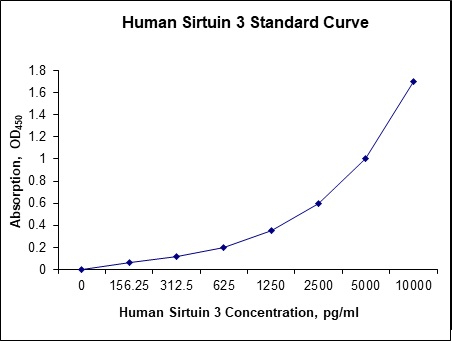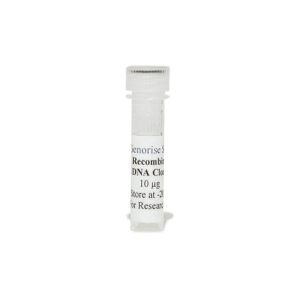Nori Human Sirtuin 3 ELISA Kit
$461.00 – $832.00
DataSheet CoA SDS
This ELISA kit is for quantification of sirtuin 3 in human. This is a quick ELISA assay that reduces time to 50% compared to the conventional method, and the entire assay only takes 3 hours. This assay employs the quantitative sandwich enzyme immunoassay technique and uses biotin-streptavidin chemistry to improve the performance of the assays. An antibody specific for sirtuin 3 has been pre-coated onto a microplate. Standards and samples are pipetted into the wells and any sirtuin 3 present is bound by the immobilized antibody. After washing away any unbound substances, a detection antibody specific for sirtuin 3 is added to the wells. Following wash to remove any unbound antibody reagent, a detection reagent is added. After intensive wash a substrate solution is added to the wells and color develops in proportion to the amount of sirtuin 3 bound in the initial step. The color development is stopped, and the intensity of the color is measured.
Alternative names for Sirtuin 3: SIRT3, NAD-dependent deacetylase sirtuin-3
This product is for laboratory research use only not for diagnostic and therapeutic purposes or any other purposes.
- Description
- How Elisa Works
- Product Citations
- Reviews (0)
Description
Nori Human Sirtuin 3 ELISA Kit Summary
Alternative names for Sirtuin 3: SIRT3, NAD-dependent deacetylase sirtuin-3
| Assay Type | Solid Phase Sandwich ELISA |
| Format | 96-well Microplate or 96-Well Strip Microplate |
| Method of Detection | Colorimetric |
| Number of Targets Detected | 1 |
| Target Antigen Accession Number | Q9NTG7 |
| Assay Length | 3 hours |
| Quantitative/Semiquantitative | Quantitative |
| Sample Type | Plasma, Serum, Cell Culture, Urine, Cell/Tissue Lysates, Synovial Fluid, BAL, |
| Recommended Sample Dilution (Plasma/Serum) | No dilution for sample <ULOQ; sufficient dilution for samples >ULOQ |
| Sensitivity | 30 pg/mL |
| Detection Range | 0.156-10 ng/mL |
| Specificity | Natural and recombinant human Sirtuin 3 |
| Cross-Reactivity | < 0.5% cross-reactivity observed with available related molecules, < 50% cross-species reactivity observed with species tested. |
| Interference | No significant interference observed with available related molecules |
| Storage/Stability | 4 ºC for up to 6 months |
| Usage | For Laboratory Research Use Only. Not for diagnostic or therapeutic use. |
| Additional Notes | The kit allows for use in multiple experiments. |
Standard Curve
Kit Components
1. Pre-coated 96-well Microplate
2. Biotinylated Detection Antibody
3. Streptavidin-HRP Conjugate
4. Lyophilized Standards
5. TMB One-Step Substrate
6. Stop Solution
7. 20 x PBS
8. Assay Buffer
Other Materials Required but not Provided:
1. Microplate Reader capable of measuring absorption at 450 nm
2. Log-log graph paper or computer and software for ELISA data analysis
3. Precision pipettes (1-1000 µl)
4. Multi-channel pipettes (300 µl)
5. Distilled or deionized water
Protocol Outline
1. Prepare all reagents, samples and standards as instructed in the datasheet.
2. Add 100 µl of Standard or samples to each well and incubate 1 h at RT.
3. Add 100 µl of Working Detection Antibody to each well and incubate 1 h at RT.
4. Add 100 µl of Working Streptavidin-HRP to each well and incubate 20 min at RT.
5. Add 100 µl of Substrate to each well and incubate 5-30 min at RT.
6. Add 50 µl of Stop Solution to each well and read at 450 nm immediately.
Background:
Sirtuin-3 (SIRT3) is a NAD-dependent deacetylase in mitochondrial and is encoded by the SIRT3 gene.[1] SIRT3 is a member of the mammalian sirtuin family, which are homologs to the yeast Sir2 protein and exhibits NAD+-dependent deacetylase activity. The human sirtuins have a range of molecular functions and have emerged as important proteins in aging, stress resistance and metabolic regulation. Sirtuins may also function as intracellular regulatory proteins with mono ADP ribosyltransferase activity. Endogenous SIRT3 is a soluble protein located in the mitochondrial matrix.[2] Overexpression of SIRT3 in cultured cells increases respiration and decreases the production of reactive oxygen species. Fasting increases SIRT3 expression in white and brown adipose tissue (WAT and BAT, respectively) and overexpression of SIRT3 in HIB1B brown adipocytes increases the expression of PGC-1α and UCP1, suggesting a role for SIRT3 in adaptive thermogenesis BAT. In addition to controlling metabolism at the transcriptional level, sirtuins also directly control the activity of metabolic enzymes. Sirt3 functions as a mitochondrial tumor suppressor protein. Although some evidence attributes SIRT3 activity in bypassing growth arrest in bladder carcinoma cells via regulation of p53 in the mitochondria.[3] Damaged and aberrant mitochondrial function, similar to gene mutations, may be an early event that ultimately leads to the development of cancers. Mice genetically altered to delete Sirt3 develop estrogen and progesterone receptor (ER/PR) positive breast mammary tumors. In tumor samples from women with breast cancer, SIRT3 expression was decreased, as compared to normal breast tissues. Thus, the Sirt3 knockout model may be used to investigate ER/PR positive breast tumor development.[4]
References
- Schwer B, et al. (2002). Journal of Cell Biology. 158 (4): 647–57.
- Onyango P, et al. (2002). PNAS 99 (21): 13653–58.
- Li S, et al. (2010). PLoS ONE. 5 (5): e10486.
- Kim HS, et al. (2010). Cancer Cell. 17 (1): 41–52.
Product Citations
Be the first to review “Nori Human Sirtuin 3 ELISA Kit”
You must be logged in to post a review.





























Reviews
There are no reviews yet.